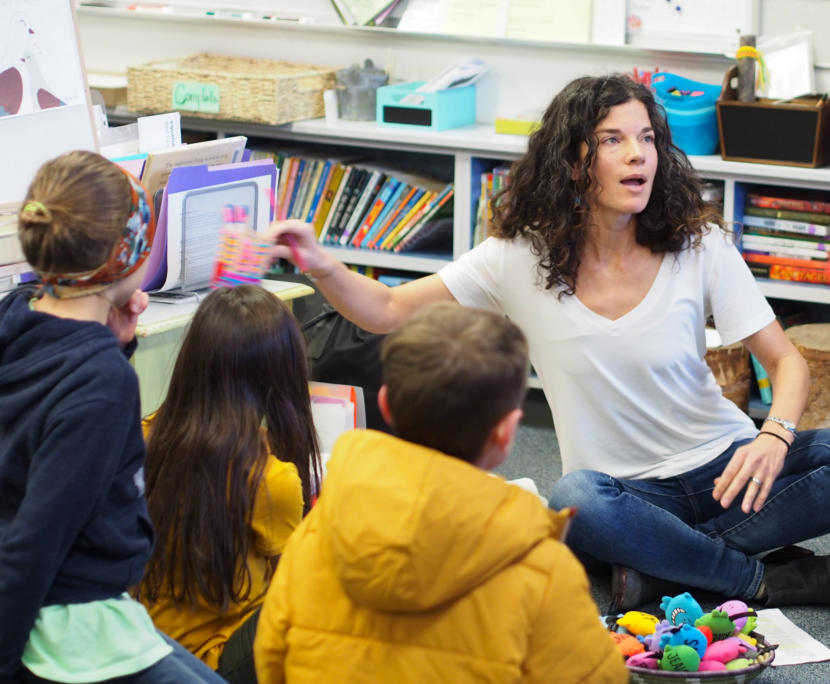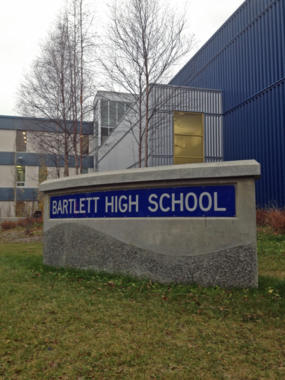
On a cold Friday morning, Mandy Casurella asked a group of 19 elementary schoolers to practice “hot chocolate breathing.”
“Smell the hot chocolate,” Casurella gently commanded as the third and fourth graders lifted imaginary mugs with deep inhalations.
“And cool it down,” Casurella added to a wave of heavy sighs.
It’s a set of breathing exercises to help the students practice calming down if they find themselves flooded with frustrated feelings, one small part of the Anchorage School District’s effort to instill what’s called “social-emotional learning” in tens of thousands of pupils.
For around 20 years, ASD has been gradually implementing and refining its SEL pedagogy. Educators inside and outside the district say that the emphasis on social skills and emotional management are critical for academic success and subsequent occupational achievement.
Across the country, more schools, school districts and states are implementing SEL curricula. ASD was an early pioneer, and a recent initiative at Harvard University’s Graduate School of Education backed up a lot of the district’s practices.
But SEL is notoriously abstract and hard to measure. Even its champions lament that there are huge inconsistencies in basic terminology. What one set of guidelines label “empathy,” might be indexed elsewhere as “self-awareness” or “active listening.”
The new Harvard initiative aims to solve some of those discrepancies, and it picked ASD’s framework for teaching SEL as one of its primary models.
Professionally, Casurella is a counselor who works with both adults and kids. As a parent at Chugach Optional Elementary School in Anchorage, she regularly volunteers with her son’s class doing social-emotional learning exercises. For about an hour, the students practice their hot chocolate breaths, label emotional reactions and navigate hurtful feelings by enacting short skits: First the kids are purposefully mean to one another, then they have to apologize and move forward.
“Ha ha, you didn’t get the quiz right, and I did!” teased one little boy, very convincingly. Then he course-corrected: “Oh, sorry, you did good on the quiz, sorry you didn’t get all the questions right.”
“I saw that,” Casurella said amid scattered applause. “Catch it, own it, redo it. That takes character, guys, and that’s what you’re practicing, so great job today. I’m really proud of you.”
Casurella believes these kinds of lessons teach children to be fluent in a lot of the same emotional and social skills that many adults don’t learn until later in life, often in therapy or counseling.
“Social-emotional learning is about giving children guidance in the world of emotions and relationships. And those are everywhere you go,” she said after the lesson was over.
According to Casurella, an emerging body of research on SEL validates its efficacy in the classroom.
That perspective is shared by the Anchorage School District. In hundreds of classrooms and among 48,500 students, ASD is implementing a standardized framework for SEL. That’s no easy task, not only because it’s a relatively new set of tools: They are hard to measure and even harder to consistently define.
“We’re all talking about these non-academic or soft skills, but we’re calling them different things, so translating them across has been really difficult,” said Jennifer Knutson, ASD’s senior director of teaching and learning.
SEL lessons in the district started at the grassroots level around 20 years ago by individual teachers, according to Knutson. In 2011, ASD became one of the first school districts in the country to adopt a defined framework.
“Some of those standards would be like: A student demonstrates awareness of their emotions,” Knutson said. “So, just like we have reading standards, we have social-emotional learning standards.”
As SEL has caught on, so have efforts to standardize and systematize it. The Harvard team recently analyzed how different institutions have developed SEL frameworks, indexed their terminologies and provided a rubric for assessing them against one another to compare emphases. Their new hub takes independently-crafted pedagogies and lets educators and parents see how they stack up against each other.
“Our goal is to allow people to navigate between those different frameworks in a way that’s very similar to a Rosetta Stone,” said Bryan Nelson, a researcher at Harvard’s Ecological Approaches to Social Emotional Learning Laboratory.
Of the 40 sets of curricula they assessed, ASD’s was the only school district with a framework for SEL education.
According to Knutson, the district is committed to SEL because it’s helping kids learn.
“It is working,” she said, though adding the caveat that “it goes up and down, and school’s vary from year to year, depending on which situations are happening.”
Knutson called the district’s current research method into SEL measures “informal,” relying on annual surveys, reports from school administrators and other performance indicators. But in schools that have focused SEL initiatives, she said there are decreases in behavior problems, higher attendance and more teacher involvement. Students who demonstrate high SEL performance tend to have better grade point averages and a greater proficiency in language arts and math, although correlation is not necessarily causation.
Chugach Optional is one of the least traditional schools in Anchorage, and the kind of free-form environment where you’d expect to see an emphasis on feelings and self-awareness. Teachers go by their first names. Students dance in the hallways before class. There’s a chicken coop near the front entrance, as well as an organic gardening club.
But SEL is not confined just to Anchorage’s progressive alternative schools: It is a district-wide set of standards.
Across town, in one of the most ethnically-diverse and socioeconomically-challenged high schools in the municipality, administrators are big SEL fans.
Each day, Principal Sean Prince and his deputies stand at the front entrance of Bartlett High School to greet every single student with a handshake, a fist-bump, a smile and the occasional side-hug.
As we spoke, Prince repeatedly stopped mid-sentence to hail kids as they passed by.
“Hey Cam!” he shouted. “Thought you were going to sneak by me?”

Among a student body of more than 1,400, Prince knows almost every student’s name. Bartlett has a lot of challenges. Seventy-five percent of its students come from low-income households, and the high school consistently ranks among the lowest in Anchorage for academic achievement, according to data from the state’s Department of Education and Early Development.
Three years ago, Bartlett started a new SEL initiative that includes steps like greeting students individually each morning. There are also efforts to give students more of a say in school culture, by having pupils rewrite the school’s mission statement and setting aside classroom time for teachers and students to negotiate a social contract. Prince also banned headphones and earbuds during the entire school day — he wanted more people talking to one another.
A former Marine who graduated from high school in Palmer, Prince said discipline was strict and sometimes arbitrary when he was a student.
“I graduated 25 years ago, and I think that those times were very different,” he said in his office.
Bartlett started implementing reforms shortly after 51% of students reported in a survey that they didn’t believe a teacher or administrator would miss them if they were gone from school. That same year, Prince said, a freshman student took his life. Not long after, efforts got under way to improve the school’s climate of connectedness. In the time since, Prince attests to a better environment at Bartlett, with performance indicators beginning to move in the same direction.
A lot of Prince’s work is with faculty and staff, training them to buy into and practice many of the same things they are tasked with guiding students through. If the SEL stuff is going to be taken seriously, Prince said, teachers have to believe it has value.
In part, because high schoolers can tell when an adult isn’t sincere.
“They have a really good BS meter. They can smell authenticity like a fresh donut,” he said. “If someone is being disingenuous in the application of an SEL thing, they’ll know it’s fake right away.”
Among the posters papering Prince’s office are big ones outlining the eight character traits his team want to inculcate in their students. There are character-building standbys like “grit” and “self-control,” right beside less traditional qualities like “social intelligence,” “gratitude,” and “zest.”
In a school contending with a lot of challenges, he says the positive impacts of SEL initiatives on Bartlett’s culture and climate are undeniable.
